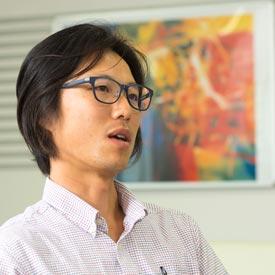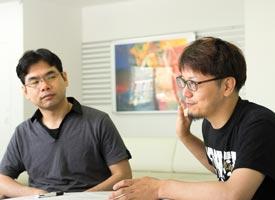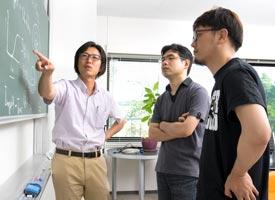

09/26/2016

Remarkable things happen when researchers get together to explore new territories at the margins of their disciplines. This is an approach that the AIMR at Tohoku University has been actively pursuing in recent years at the border between mathematics and materials science.
In 2010, a seminar held at the AIMR spawned discussions between a mathematician, an experimentalist and a physicist. Six years later, this initial discussion has blossomed into groundbreaking findings in an emerging area of mathematics known as persistent homology, with the three researchers able to characterize the underlying atomic order of a class of materials having mostly random structures. Until now, this order had remained elusive to scientists using conventional methods.
For a mathematician, Yasuaki Hiraoka certainly has an unconventional resume: he started off studying electrical engineering at Osaka University and now works at a center for materials science — the AIMR. He is passionate about exploring the interface between mathematics and applied sciences. Hiraoka first learned that there could be more to a career in mathematics than abstract thought from his master’s supervisor, Yuji Kodama, who is now a professor at The Ohio State University. “He’s my inspiration in that he does serious mathematics — he’s a pure mathematician — but he’s also famous in the field of optical communications,” Hiraoka says. “I wanted to become like him.”
Hiraoka is not just interested in applying mathematics to real systems; he also works in the opposite direction — using applications to generate new mathematics. “I’m eager to develop my own mathematics,” he says.
These interests explain why Hiraoka is so enthralled by the emerging field of persistent homology — a powerful mathematical framework that can uncover patterns buried in large sets of data. First developed at the beginning of the twenty-first century, persistent homology has taken off in recent years, finding applications in fields as diverse as neuroscience, linguistics, particle theory and artificial intelligence. Hiraoka considers it a tremendously exciting time to be working in the field.
The power and versatility of persistent homology lie in its ability to mathematically express the multiscale organization so often observed in natural phenomena. For example, before coming to the AIMR, Hiraoka used persistent homology to explore the structures of bioproteins, and, in particular, used it to link the structure of a protein to how compressible it is.
Today, Hiraoka heads a group at the AIMR that is leading the charge in applying persistent homology to materials science. “We are the only group in the world seriously applying persistent homology to materials,” he says.
Hiraoka had just finished writing a book on the subject when the AIMR invited him to speak at a seminar. It was there that he first met his future collaborators, Akihiko Hirata and Takenobu Nakamura.

Akihiko Hirata is the experimentalist of the trio. His interest lies in using analytic techniques such as electron diffraction and transmission electron microscopy to probe the atomic structures of so-called amorphous materials such as bulk metallic glasses and other glasses. Unlike crystalline materials, these glasses do not have periodic arrangements of atoms or molecules, which makes experimental analysis of them far from straightforward. Their disordered structures produce blurry diffraction patterns and complex micrographs, which are extremely challenging to glean meaningful structural information from. To make sense of the data, Hirata needed to consult with a mathematician familiar with persistent homology — Hiraoka’s visit offered the perfect opportunity.
It was not the first time that Hirata had collaborated with a mathematician. Together with mathematician Kaname Matsue (then an assistant professor at the AIMR), Hirata had previously explored the structure of metallic glasses using an angstrom-beam electron diffraction technique he helped develop, which uses an electron beam only several atoms thick to obtain diffraction patterns. They produced the first experimental evidence for order with the same symmetry as a 20-sided polygon (icosahedron) in metallic glasses. “It was a great, fresh experience for me,” says Hirata of the study published in Science in 20131. “I was inspired by mathematicians.”
Interpreting between the two worlds comes naturally to Takenobu Nakamura, a physicist who understands the terminologies used by mathematicians and experimentalists. He has honed his interpretive skills through studying subjects heavy in mathematics, such as statistical physics and non-equilibrium, nonlinear physics.
At the AIMR, Nakamura works as a researcher in the Interface Unit, which serves as a bridge between materials scientists and mathematicians. Even with that background, it still takes him some time to become proficient enough to tackle a new project. “The first thing I do is learn both terminologies by making a translation table for the two fields,” he says. “Then we can start the conversation.”
Seeing the potential of using persistent homology to characterize the structure of amorphous solids, the trio began establishing common ground. Nakamura’s experience proved invaluable in this endeavor. “Before seriously starting this work, we took several months just to set up a common terminology and frame of reference,” says Hiraoka. “We wanted to find our ‘sweet spot’.”
Working together, the three researchers eventually discovered that they could use a special diagram based on persistent homology — known as a persistence diagram — to visualize the structure of amorphous solids. Curves in a persistence diagram indicate the presence of local structures. The researchers demonstrated this for pure glass and found that it contains different ring-like configurations of atoms (see related highlight). “The first time we found this curve, we knew it was what we had been searching for,” says Hiraoka. Such structures had never been seen before in glass. The results were published in Proceedings of the National Academy of Sciences USA in June 20162. “I don’t think any two of us working together could have obtained this result,” says Hiraoka. “It took all three of us.”
More importantly, the approach demonstrated the power of persistent homology to unveil structures hiding in the randomness of amorphous solids. The researchers intend to apply this approach to other amorphous materials and to generate new mathematics. “We first focused on silica, but the developed methods are applicable to a wide range of other glass structures,” says Nakamura.

The finding was also due to the special environment cultivated at the AIMR. The institute has created many opportunities for mathematicians and materials scientists to interact and work with each other through target projects, fusion research, workshops and seminars, including the Target Project–Interface Unit Joint Forum. The culture of exploring the interface between mathematics and materials science is deeply ingrained in the institute’s DNA.
Recent successes flowing from this outlook include the synthesis and exploration of belt-shaped ‘nanohoops’ by Hiroyuki Isobe’s team3. Various other collaborative studies have led to discoveries in the stoichiometric control of deposited thin films using a stochastic model, formulation of the bulk-edge correspondence of topological insulators based on K-theory, mathematical modeling of periodic structures observed along grain boundaries, as well as the prediction of phase separation morphologies of block copolymers using Cahn−Hilliard equations.
Hiraoka is appreciative of the environment at the AIMR. “Director Kotani allowed me to establish a laboratory, which is really unusual in the mathematics community,” he says. “Mathematics is usually done by individuals working alone. But in some cases, it’s also good to organize a team to enhance the research field more aggressively. Persistent homology has now become such a field.”